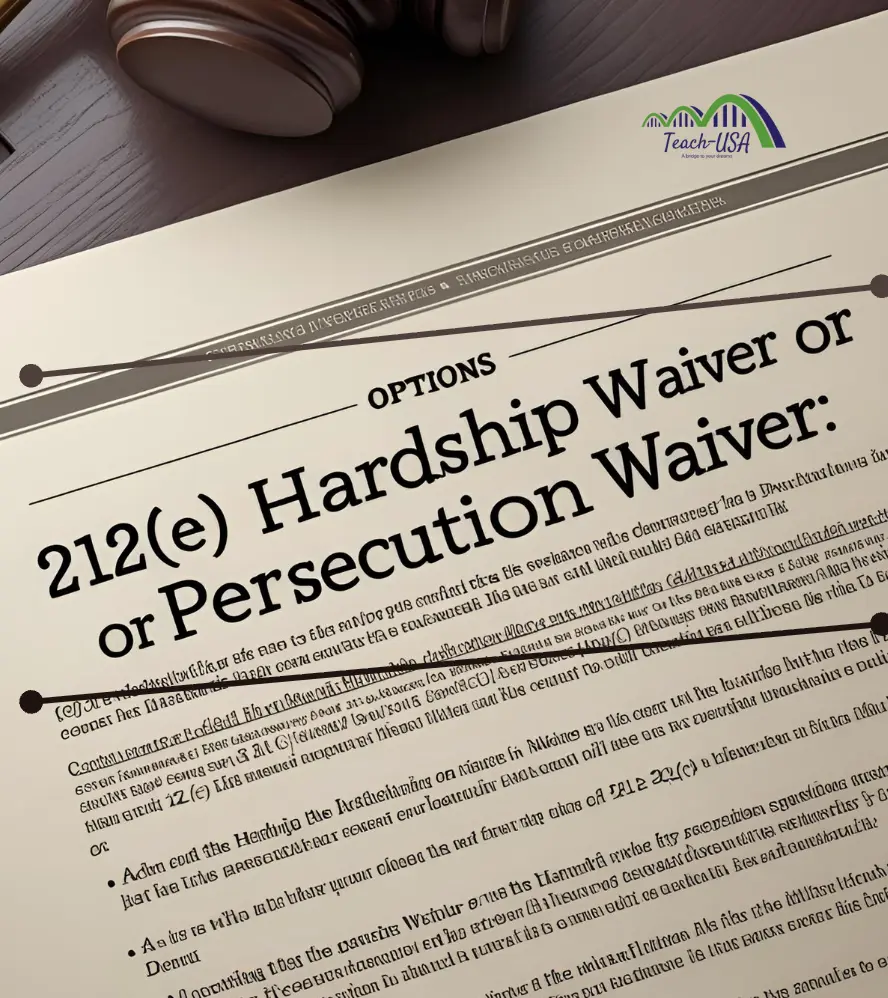For many international teachers in the U.S. on a J-1 visa, the two-year home residency requirement under Section 212(e) can feel like the biggest hurdle in planning their future. The rule requires certain J-1 visa holders to return to their home country for at least two years before they can apply for another long-term U.S. visa or a green card.
But here’s the good news: there are legal pathways called waivers that may allow you to bypass the 212(e) requirement if you qualify. Two of the most commonly used waivers are the Hardship Waiver and the Persecution Waiver.
1. Hardship Waiver
The hardship waiver is an option if your departure would cause exceptional hardship to a U.S. citizen or lawful permanent resident spouse or child.
This means:
- If you’re married to a U.S. citizen and returning home would create significant emotional, financial, or medical hardship for your spouse, you may qualify.
- If you have a U.S.-born child, the impact on their well-being, education, or health can also be considered grounds for hardship.
👉 Important: This hardship applies no matter where you’re from—it focuses on the well-being of your U.S. family, and may also consider how conditions in your home country could affect them if they had to relocate.
Examples of hardship that can strengthen your case:
U.S.-Based Hardship
- A U.S. spouse or child has a medical condition requiring ongoing treatment available only in the U.S.
- The U.S. spouse’s career, education, or financial stability would be severely disrupted if forced to relocate abroad.
- The psychological or emotional toll of family separation on a U.S. child or spouse is beyond ordinary adjustment.
Home-Country Hardship
Ongoing political instability, conflict, or poor living conditions in the home country that would endanger the family.
The U.S. spouse or child would face safety risks or lack of basic healthcare if they had to live abroad.
Limited educational opportunities for U.S. children compared to the U.S. school system.
2. Persecution Waiver
The persecution waiver may be available if you can show that returning to your home country would subject you to persecution based on political opinion, religion, race, nationality, or membership in a particular social group. This is a higher standard than ordinary hardship—it requires proof of actual or highly probable persecution (USCIS Policy Manual).
General Examples:
- Being targeted because of your political beliefs.
- Facing gender-based persecution such as denial of rights or targeted violence.
- Returning to an area with war or ongoing conflict, where basic safety cannot be guaranteed.
Mindanao, Philippines: A Real-World Example
For J-1 teachers from Mindanao, ongoing conflict and instability may elevate their case for a persecution waiver:
- Prolonged conflict and insurgency: Armed groups in Mindanao have displaced over 2 million people in recent decades (Moro Conflict – Wikipedia).
- Ethnic and religious targeting: Indigenous Lumad communities face displacement, school closures, and harassment tied to land disputes and militarization (Lumad – Wikipedia).
- Human rights abuses: Reports describe extrajudicial killings, forced displacement, and destruction of schools in Indigenous areas (TIME – “Philippines’ Hidden War”).
- Terrorist violence: The 2023 ISIS-linked bombing at Mindanao State University highlights ongoing threats to civilian safety (MSU Bombing – Wikipedia).
These conditions illustrate grave threats to personal safety and human rights—factors that may substantiate a persecution waiver if supported with solid country-condition reports, affidavits, and legal advocacy.
This waiver is about protection—ensuring that you are not forced back into a situation that threatens your life, dignity, or human rights. For teachers from regions like Mindanao, where ethnic, religious, and political conflict continues, the persecution waiver could be a critical legal pathway—if backed by strong documentation and legal guidance.
Strengthen Your Case with Documentation
If you’re considering a persecution waiver, here’s what can help:
- Country condition reports from credible sources (e.g., U.S. State Department, UN bodies).
- Firsthand accounts of violence, harassment, or forced displacement.
- Expert letters or affidavits—from NGOs, legal groups, or human rights organizations familiar with Mindanao.
- Media reports or fact sheets showing incidence of targeted conflict, militarization, or ethnic violence.
Why This Matters for J-1 Teachers
Many teachers on J-1 visas feel torn between their career, their family, and the rules of immigration law. The 212(e) waiver pathways exist to provide relief in very real and serious situations. If you’re married, have a U.S. child, or come from conflict-affected regions like Mindanao, Philippines, these options could be life-changing.
However, these waivers are not automatic. They require strong evidence, careful preparation, and in most cases, the guidance of an experienced immigration lawyer.
What Do You Think?
If you are a J-1 teacher considering your future in the U.S., it’s worth learning about the hardship and persecution waivers under 212(e). While the process can be complex, knowing your options is the first step toward creating stability for yourself and your family.
If you think your situation may qualify—especially if you’re from areas such as Mindanao, Philippines—email apply@teach-usa.net with the subject line “212e waiver” to explore your options. We can also refer you to our trusted immigration lawyer for a professional case review and guidance.
When you email, please also include your phone number if you are willing to be referred to the lawyer so they can contact you directly.

